Al Gore "An Inconvenient Truth"

Al Gore "An Inconvenient Truth" |
 |
Part 1 (08:00 - 25:10) |
|
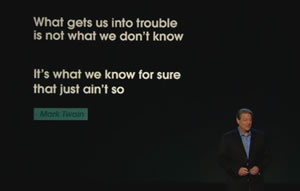 |
The |
This is actually an important point, believe it or not because there is another such assumption that a lot people have in their minds right now about global warming that just isn’t so. The assumption goes like this: |
Maybe that was true at one time, but it is not true any more. One of the reasons it is not true anymore, because one of the most vulnerable parts is the atmosphere because it’s so thin. My friend the late Carl Sagan used to say that if you have a globe with a thin coat of varnish on it, the thickness of that varnish relative to that globe is pretty much the same as the thickness of the earth’s atmosphere compared to the earth itself. It is thin enough that we are capable of changing its composition. |
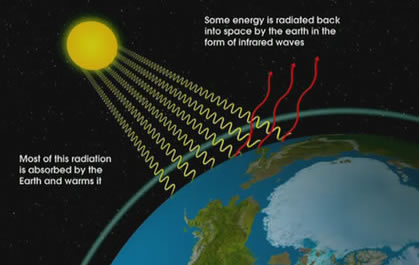 |
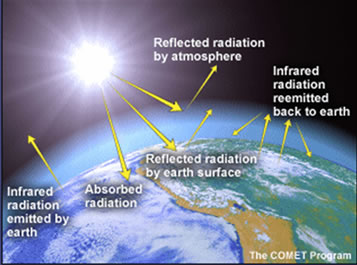 |
That brings up the basic science of global warming. The sun’s radiation comes in the form of light waves and heats up the earth. Some of the radiation that is absorbed and warms the earth is re-radiated back into space in the form infrared radiation. Some of the outgoing infrared radiation is trapped inside the atmosphere. That is good thing because it keeps the temperature of the earth within certain boundaries, keeps it relatively constant and livable. |
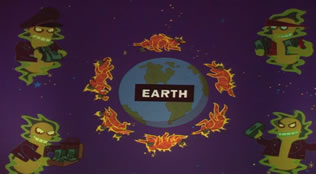 |
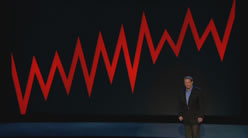 |
Why do carbon dioxide levels go up and down once each year? If you look at the land mass of the earth, very little of it is south of the equator. The vast majority of it is north of the equator. And most of the vegetation is north of the equator. When the northern hemisphere is tilted toward the sun (see the visualization) as it is in our spring and summer, the leaves come out and they breathe in the carbon dioxide and the amount in the atmosphere goes down. When the northern hemisphere is tilted away from the sun as it is in our fall and winter, the leaves fall down and exhale the carbon dioxide and the amount in the atmosphere goes up again. It’s as if the entire earth once each year breathes in and out. |
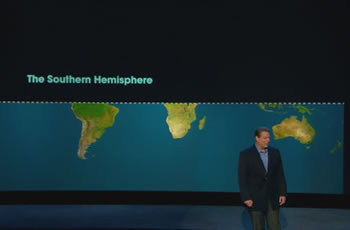 |
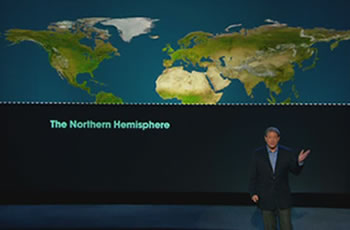 |
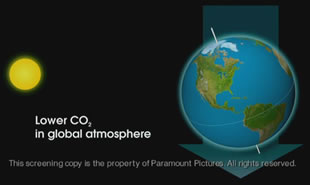 |
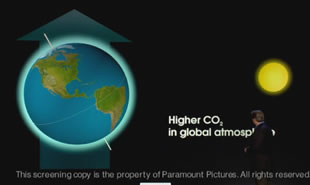 |
The carbon dioxide levels keep going up. It is relentless. |
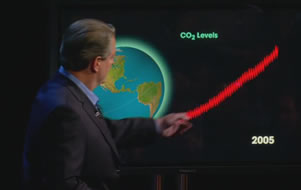 |
Effects of Global Warming 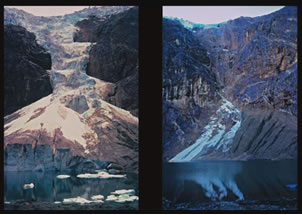 |
|
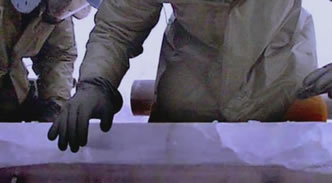 |
The ice has a story to tell and it is worldwide Scientists dig cores in the ice. They dig down and they bring the core drills back up and they look at the ice and they study it. When the snow falls, it traps little bubbles of atmosphere. They can go in and measure how much CO2 was in the atmosphere the year that that snow fell. What’s even more interesting I think is they can measure the different isotopes of oxygen and figure out the very precise thermometer and tell you what the temperature was the year that bubble was trapped in the snow as it fell. |
Ice Cores: The 1,000 Record They can count back year by year the same way a forester reads tree rings. You can see each annual layer from the melting and refreezing. They can go back in a lot of these mountain glaciers a thousand years. They constructed a thermometer of the temperature. The blue is cold and the red is warm. |
|
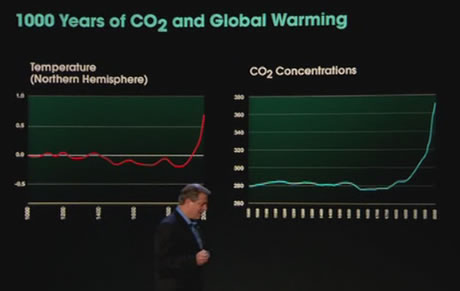 |
I show this for a couple of reasons. Number one the so called skeptics will sometimes say “Oh, this whole thing is cyclical phenomenon. There was a medieval warming period after all.” Well yeah there was. There it is right there. There are one there and two others. But compared to what is going on now, there is just no comparison. So if you look at a thousand years worth of temperature and compare it to a thousand years of CO2 you can see how closely they fit together. |
Ice Cores: The 650,000 Record |
Now, a thousand years of CO2 data in the mountain glacier. That is one thing. But in Antarctica, they can go back 650,000 years. This, incidentally, is the first time anybody outside of a small group of scientists have seen this image. This is the present day era and that’s the last ice age. Then it goes up. We’re going back in time now 650,000 years. That’s the period of warming between the last two ice ages back. That’s the second and third ice age back. |
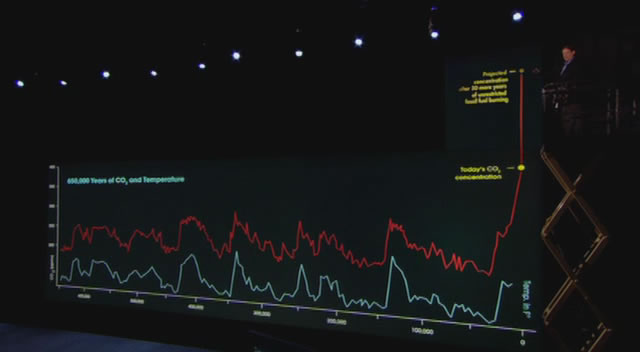 |
CO2 concentration |
Now an important point: In all of this time, 650,000 years, the CO2 level has never gone above 300 parts per million. Now, as I said, they can also measure temperature. Here is what the temperature has been on our earth. One thing that kind of jumps out at you is... Let me put it this way: If my classmate from the sixth grade that talked about Africa and South America were here, he might have said, “Did they ever fit together?” Most ridiculous thing I ever heard. But they did of course. The relationship is very complicated. But there is one relationship that is far more powerful than all the others and it is this: When there is more carbon dioxide, the temperature gets warmer, because it traps more heat from the sun inside. This is the difference between a nice day and having a mile of ice over your head. Keep that in mind when you look at this fact. Carbon dioxide having never gone above 300 PPM, here is where CO2 is now. We give off where it has never been as far back as this record will measure. If you will bear with me I would like to emphasize this point. It’s already right here. Look how far above the natural cycle this is, and we’ve done that. But ladies and gentlemen, in less than 50 years it’s going to continue to go up. When some of these children who are here are my age, here’s where it’s going to be in less than 50 years. Within less than 50 years it’ll be here. There’s not a single fact or day or number that’s been used to make this up that is in any controversy. The so-called skeptics look at this and say, “So, that looks seems perfectly okay.” Well, on the temperature side: If this much on the cold side is a mile of ice over our heads, what would that much on the warmer side be? This is really not a political issue so much as a moral issue. If we allow that to happen, it is deeply unethical. |
|